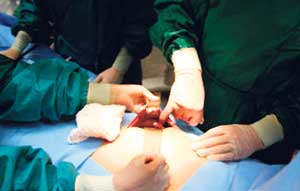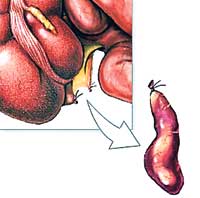
When inflamed sac has to come outIn this new series on commonly performed surgical operations, Dr. Melanie Amarasooriya takes us through an appendix operation with Dr. Nalitha Wijesundera, Consultant Surgeon, Karapitiya Teaching Hospital. Mahimi, a 23-year-old who was married just two months ago, had been having a strange abdominal pain since early in the morning. It was initially around her umbilicus (belly button), occurring from time to time, the pain lasting a few minutes each time. She was not feeling well and a little feverish. After a few hours, around lunch time, the pain was in the right lower abdomen, worsening when she tried to cough or breathe deeply. Mahimi had no appetite, and felt nauseous. Her temperature was not very high, although she was feverish; the thermometer reading being 99.6.
However her abdominal pain continued to increase and by the time her husband returned home, she had vomited twice. She was taken to hospital. There the 'doctor-on call' examined her to find that her tummy was extremely painful. Mahimi looked very ill by this time and the husband was anxious. "This is a classic picture of appendicitis, with abdominal pain migrating from the umbilical region to the right lower abdomen, with the other features," explained the doctor to her husband. However, they needed to exclude a ruptured ectopic pregnancy, before they opened up, he said. The symptoms of appendicitis can be different to what Mahimi experienced. Some patients straightaway feel the right lower abdominal pain. Some have constipation whereas some have diarrhoea. Mahimi was kept fasting with the intravenous drip so that she could be taken to the operating theatre immediately. Meanwhile, she was rushed for an ultrasound scan of the abdomen. Although she had the typical features of appendicitis, doctors were concerned that this could be due to a pregnancy, which is outside the womb (ectopic), getting ruptured. Despite being rare, it is a possibility in any young woman presenting with sudden severe lower abdominal pain and is a deadly condition if not attended to immediately. It leads to bleeding into the abdomen and can kill a patient. Thankfully, Mahimi's ultrasound scan showed no intra-abdominal bleeding. The working diagnosis of appendicitis was made, and basic blood and urine investigations sent and she was taken into the theatre. Mahimi's father who was anxious about the condition asked the doctor whether she can be cured without this emergency surgery. "No, if we keep her waiting the appendix could rupture, which could be fatal," replied the doctors, who then obtained the consent for the surgery. The surgery took about one hour, and Mahimi was unconscious throughout the period. A small incision about one and half inches was made along the skin creases, in the right lower abdomen and the inflamed appendix removed. Mahimi was prescribed intravenous antibiotics for a day. She made a good recovery after the surgery and after two days was discharged. "Wounds will heal in about 5 to 7 days and after that you can attend to your routine work. Till then the limitation of your work should be just the pain. You can take paracetamol for pain if needed," the doctor advised her on discharge. The scenario is not similar if the patient comes with a ruptured appendix. With good antibiotic coverage, the patient should be immediately operated with a large incision opening into the abdominal cavity. All the infected material is washed with saline or antibiotic liquid and the opening sutured. However, this is a life threatening condition and needs vigorous treatment. Uncomplicated appendicitis can also be operated laparoscopically, where three ports are made on the abdomen and a video camera is sent in and the patient operated with minimal invasive procedure. The recovery time is a little less in this procedure and the scars are not visible. However, laparoscopic appendicectomy needs greater technical expertise than open surgery. This is quite a common operation here. It serves no function
The appendix is a rudimentary worm-like structure in the gastro-intestinal tract which serves no function. It could get inflamed suddenly without a particular cause, and this happens commonly in childhood to young adulthood. Inflammation of the appendix is termed appendicitis. If the process goes on, this small tube can rupture, leaking the faecal matter which is supposed to be inside the bowels, into the abdominal cavity. This leads to generalized infection and is fatal. In other cases, even without rupturing it can form into an abscess, where the surrounding structures also get attached to the inflamed appendix. This needs vigorous treatment with the patient in hospital. Before any of the complications occur, acute appendicitis needs surgical intervention. Appendicectomy - How it is done
|
|| Front
Page | News | Editorial | Columns | Sports | Plus | Financial
Times | International | Mirror | TV
Times | Funday
Times | Medi Scene || |
| |
Reproduction of articles permitted when used without any alterations to contents and the source. |
© Copyright
2008 | Wijeya
Newspapers Ltd.Colombo. Sri Lanka. All Rights Reserved. |

